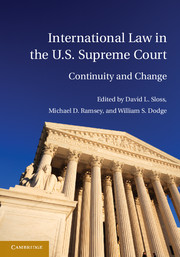Book contents
- Frontmatter
- Contents
- List of Contributors
- Table of Cases
- Acknowledgments
- Introduction
- PART I FROM THE FOUNDING TO THE CIVIL WAR
- PART II FROM THE CIVIL WAR TO THE TURN OF THE CENTURY
- PART III FROM THE TURN OF THE CENTURY TO WORLD WAR II
- PART IV FROM WORLD WAR II TO THE NEW MILLENNIUM
- 10 Treaties in the Supreme Court, 1946–2000
- 11 Customary International Law in the Supreme Court, 1946–2000
- 12 International Law as an Interpretive Tool in the Supreme Court, 1946–2000
- 13 Global Power in an Age of Rights: Historical Commentary, 1946–2000
- PART V INTERNATIONAL LAW IN THE U.S. SUPREME COURT IN THE TWENTY-FIRST CENTURY
- V.A TREATIES AFTER 2000
- V.B CUSTOMARY INTERNATIONAL LAW AFTER 2000
- V.C INTERNATIONAL LAW AND CONSTITUTIONAL INTERPRETATION AFTER 2000
- V.D INTERNATIONAL LAW AND STATUTORY INTERPRETATION AFTER 2000
- V.E INTERNATIONAL LAW AND THE WAR ON TERROR
- VI CONCLUSION
- Index
- References
13 - Global Power in an Age of Rights: Historical Commentary, 1946–2000
Published online by Cambridge University Press: 05 July 2011
- Frontmatter
- Contents
- List of Contributors
- Table of Cases
- Acknowledgments
- Introduction
- PART I FROM THE FOUNDING TO THE CIVIL WAR
- PART II FROM THE CIVIL WAR TO THE TURN OF THE CENTURY
- PART III FROM THE TURN OF THE CENTURY TO WORLD WAR II
- PART IV FROM WORLD WAR II TO THE NEW MILLENNIUM
- 10 Treaties in the Supreme Court, 1946–2000
- 11 Customary International Law in the Supreme Court, 1946–2000
- 12 International Law as an Interpretive Tool in the Supreme Court, 1946–2000
- 13 Global Power in an Age of Rights: Historical Commentary, 1946–2000
- PART V INTERNATIONAL LAW IN THE U.S. SUPREME COURT IN THE TWENTY-FIRST CENTURY
- V.A TREATIES AFTER 2000
- V.B CUSTOMARY INTERNATIONAL LAW AFTER 2000
- V.C INTERNATIONAL LAW AND CONSTITUTIONAL INTERPRETATION AFTER 2000
- V.D INTERNATIONAL LAW AND STATUTORY INTERPRETATION AFTER 2000
- V.E INTERNATIONAL LAW AND THE WAR ON TERROR
- VI CONCLUSION
- Index
- References
Summary
A good historical account seeks to make out the big picture from small facts. Reviews of a given interpretation therefore range from grand theoretical critiques to picking the smallest nits, often at the same time. When provided with not one but three meticulous chapters, commentary becomes an even greater challenge in each regard.
No big picture at first seems clear and not just because here are three separate treatments of three discrete aspects of the Supreme Court's use of international law. More importantly, the post–World War II era appears to stand in stark contrast to a period such as the Founding. It seems fairly apparent that, at the Founding, doctrine followed the reality that the United States was a small, fledging Republic seeking the protection of the law of nations. By contrast, doctrine in the postwar period seems at times internationalist and at times nationalistic within all three categories: treaties, custom, and interpretation.
The disarray seems all the more odd given what should have happened. No more obvious development in foreign affairs characterized the era than the United States' emergence as the preeminent superpower, rivaled only by the Soviet Union. It would follow that, just as the new Republic embraced international law in its infancy, the new hegemon would ignore it in its maturity. The main likely exception would be those instances when international law facilitated rather than obstructed U.S. foreign policy goals.
- Type
- Chapter
- Information
- International Law in the U.S. Supreme Court , pp. 416 - 442Publisher: Cambridge University PressPrint publication year: 2011



